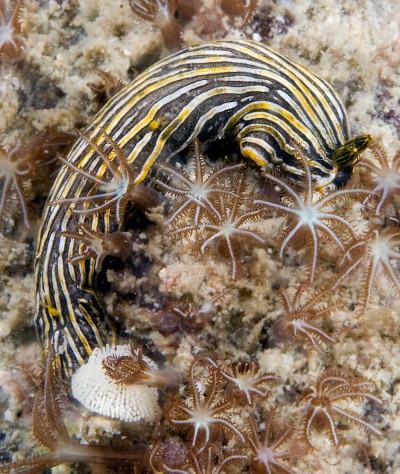Dermatobranchus striatus ? from the Gulf of Thailand
March 11, 2010
From: Lawrence Neal

Dear Bill,
Here are some photos of what I believe is Dermatobranchus striatus (van Hasselt, 1824) from different parts of the Gulf of Thailand.
Upper Photo: Koh Hu Chang, Pattaya, Chonburi Province, Thailand, Gulf of Thailand, 6 metres, Length: 25 mm. 24 January 2010. Middle left photo: closeups from upper photo showing mantle and yellow copepod. Middle right Photo: Koh Yippon, Angthong Marine Park, Surat Thani Province, Thailand, Gulf of Thailand, 13 metres. Length: 30 mm. 5 July 2009. Lower Photo: Koh Rin, Pattaya, 12 metres, Chonburi province, Thailand, Gulf of Thailand, 12 October 2008, Hard coral reef. Length: 20 mm. Photographer: Lawrence Neal.
I don't have a copy of van Hasselt's original description from Indonesia but a redescription by Baba based on individuals collected from Okinawa (25 mm and 35 mm alive) gives the following description:
"The body can be greatly extended or shortened according to the movement of the animal The head veil (or oral veil) is smooth. The back is provided with numerous fine longitudinal folds or ridges. Both sides of the body are entirely smooth
"The main colour features of this species are the following: (1) Dorsally the head veil is black-brown with transverse white lines. (2) The ground colour of the back is also black-brown. Each of the longitudinal ridges bears a white line on its crest, forming white ovoid patches at some places. (3) The rhinophores are deep yellow apically, black-brown on the clubs and colourless on the stalks. (4) The extreme edges of the head veil, mantle and foot are bordered with a narrow yellow line. The sides of the body and the foot sole are white."
The photographed individuals from Thailand seem to correspond quite well with this description and with the drawings in Baba's paper, although most individuals from Thailand seem to have varying amounts of yellow within the white lines of the longitudinal ridges. The black semi-circular marking on the dorsal oral veil seems to be characteristic.
From the information I can glean, current geographical range is Indonesia, Japan, Papua New Guinea and the Gulf of Thailand.
This species is quite common at many sites in the Gulf of Thailand, usually found in association with its prey food: mat-forming stoloniferous octocorals which cover rocks in reef areas. I understand the octocoral is a species of Briareum (previously Polyclavularia??). Individuals are often infested with bright yellow copepod parasites.
Interestingly, a similar species, Dermatobranchus albus, is present in the Andaman Sea off Western Thailand and feeds on a very similar (but not identical) species of Briareum. To date, I have never come across (or heard of) D. striatus in the Andaman Sea, nor D. albus in the Gulf of Thailand.
I feel fairly certain that the nudibranch in message #2921 listed as Armina cf. japonica is also this species, taking into consideration its appearance, size, location and the presence of the same octocoral in the photograph.
- Baba, K. (1992) Critical Review of Dermatobranchus striatus van Hasselt, 1824 (Nudibranchia: Arminidae) with the Description of a New Species. Japanese Journal of Malacology Vol. 53, No. 4 (1992): 239-248
Best wishes,
Lawrence
lorenzo_n@yahoo.com



Dear Lawrence,
Your message is interesting on many fronts. First its identity. I agree with you that it is almost certainly the same as the animal I have 'labelled' as Armina cf. japonica. As I query in my reply to that message I am uncertain if it is a species of Armina or of Dermatobranchus but noted a likeness to Armina japonica [see also Kathe Jensen's message [#2957]] It is difficult to separate species of Armina and Dermatobranchus just from photos, but your observation of the animals always associating with stoloniferous octocorals is a good clue that they are indeed a species of Dermatobranchus as species of Armina as usually found feeding on sea pens.
Concerning what species it is. I have my doubts whether Baba's animal is the same as van Hasselt's and am not sure we can ever be sure. There are quite a few species of Dermatobranchus with white ridges on a black background many of which seem to be unnamed. Your animal differs from Baba's in the distinctive yellow line long each white ridge and the colour of the rhinophores. This may seem minor but it may reflect major internal differences. Chromodorids are not the only group in which small colour pattern differences can be highly significant. We also have little idea of colour variation within a species. Just in your photos we can see that the head can be edged in yellow but in some animals they yellow is absent.
For that reason I prefer to leave this species as Dermatobranchus sp. 9 rather than confuse the issue by having a number of potentially different species all labelled as one.
I also noticed a couple of the yellow copepods on one of your animals which I have added a close-up of, and also a closeup of what could well be an egg ribbon of this species. The size of the eggs suggest they belong to an animal with abbreviated larval development. It would be interesting to keep a few egg ribbons in an aquarium and see if the larvae hatch out as crawling young slugs rather than as swimming veliger larvae.
Best wishes,
Bill Rudman
Related messages
-
Re: Dermatobranchus striatus ? from the Gulf of Thailand
From: Bill Rudman, March 11, 2010 -
Re: Armina cf. japonica from Thailand
From: Kathe R. Jensen, September 1, 2000 -
Armina cf. japonica from Thailand
From: Narongpon Sittithaweepat, August 31, 2000
